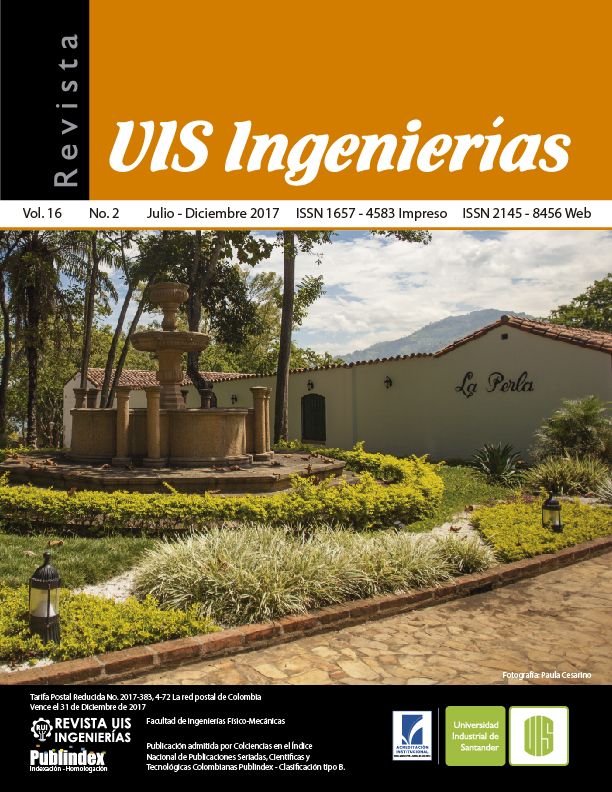An approach for optimal dimensional synthesis of a 5R parallel robot for a CNC X-Y cutter
Published 2017-05-17
Keywords
- Parallel robot,
- genetic algorithm,
- optimization,
- dexterity
How to Cite
Abstract
Planar robots can perform industrial tasks such as CNC X-Y cutter. Among them, the 5R two-degrees-of-freedom (2-DoF) planar parallel robot can become a useful conceptual design. Parallel robots are made of several closed kinematic chains, which gives them a structure enabling to bear more payload. These robots present the advantages of better load/size capacity, speed, rigidity and precision, while their main drawback is the limited workspace. The paper aim to design the 5R-2DoF parallel robot so that its reachable workspace will be maximum and also with optimal dexterity. In this sense, we take advantage of the Genetic Algorithms (GA) in order to develop an approach for optimal design of the robot. The paper shows a path to follow to design the robot taking into account a maximum workspace with dexterity. We present two study cases to test the performance of the proposed approach.
Downloads
References
Ortiz-Pimiento, N.R., Gómez-Gómez, S. “Desarrollo de un algoritmo genético para el diseño de sistemas de manufactura celular a partir de una nueva función de aptitud”. Revista UIS Ingenierías, vol. 6, no.2, pp 71-83, 2007.
D.A. Bueno-Sierra, R. Martínez-Ángel, "Planeación de trayectorias para un robot en una celda de manufactura." Revista UIS Ingenierías vol. 1, no 2, pp 31-41, 2002.
J.P. Merlet, “Workspace-oriented methodology for designing a parallel manipulator”. In Robotics and Automation, 1996. Proceedings of IEEE International Conference on, 1996, vol. 4, pp. 3726-3731.
J.P. Merlet, “Jacobian, manipulability, condition number, and accuracy of parallel robots”. Journal of Mechanical Design, vol. 128, no. 1, pp. 199-206, 2006.
X.J. Liu, J. Wang, G. Pritschow, “Kinematics, singularity and workspace of planar 5R symmetrical parallel mechanisms”. Mechanism and Machine Theory, vol. 41, no. 2, pp. 145-169, 2006.
M.A. Laribi, L. Romdhane, S. Zeghloul, “Analysis and dimensional synthesis of the DELTA robot for a prescribed workspace”. Mechanism and Machine Theory, vol. 42, no. 7, pp. 859-870, 2007.
J. Wu, T. Li, X. Liu, L.Wang, “Optimal kinematic design of a 2-dof planar parallel manipulator”. Tsinghua Science & Technology, vol. 12, no. 3, pp. 269-275, 2007.
Y. Lou, G. Liu, Z. Li. “Randomized optimal design of parallel manipulators”. IEEE Transactions on Automation Science and Engineering, vol. 5, no. 2, pp. 223-233, 2008.
S.D. Stan, V. Maties, V.R. Balan, “Optimal design of parallel kinematics machines with 2 degrees of freedom”. In Parallel Manipulators, Towards New Applications, I-Tech Education and Publishing, 2008, pp. 295-320.
E. Martínez, C.A. Peña, E. Yime, “Diseño óptimo de un robot paralelo con configuración delta para aplicaciones educativas”. Revista Educación en Ingeniería, vol. 5, no. 10, pp. 110-119, 2010.
O. Altuzarra, B. Sandru, E. Amezua, “Análisis de indicadores cinemáticos para el diseño de manipuladores paralelos”. In XVIII Congreso Internacional de Ingeniería Mecánica, Ciudad Real España, 2010.
M. Díaz-Rodríguez, X. Iriarte, V. Mata, J. Ros, “On the experiment design for direct dynamic parameter identification of parallel robots”. Advanced Robotics, vol. 23, no 3, p. 329-348. 2009.
M.Z. Huang, “Design of a planar parallel robot for optimal workspace and dexterity”. International Journal of Advanced Robotic Systems, vol. 8, no. 4, pp. 176-183, 2011.
C.A, Peña-Cortés, E. Martínez-Oviedo, P.F. Cárdenas-Herrera. “Optimización dimensional de un robot paralelo tipo delta basado en el menor consumo de energía”. Ciencia e Ingeniería Neogranadina, vol. 21, no. 1, pp. 73-88, 2011.
B. Bounab, “Multi-objective optimal design based kineto-elastostatic performance for the delta parallel mechanism”. Robotica, vol. 34, no. 02, pp. 258-273, 2016.
A. Barraza Cantillo, J. Rúa Charris, J. Sosa Rodríguez, J. Díaz González, E. Yime Rodríguez, J. Roldán Mckinley, “Modelado dinámico del manipulador serial Mitsubishi Movemaster RV-M1 usando SolidWorks”, Revista UIS Ingenierías, vol. 15 (2), pp 49-62, 2016, doi:10.18273/revuin.v15n2-2016004.
J.H. Holland. Adaptation in natural and artificial systems. Ann Arbor: The University of Michigan Press, 1975.


